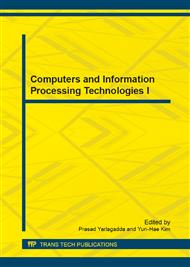[1]
Dirk Helbing, IlleÂs Farkas & TamaÂs Vicsek: Simulating dynamical features of escape panic, NATURE , Vol. 407 (2000), http: /www. nature. com.
DOI: 10.1038/35035023
Google Scholar
[2]
H. Ozaki and A. Kara: Computing the Availability and MTTF of Shared Protection Systems, IEEE CIT2007(2007).
Google Scholar
[3]
Jue Chen: Improving reliability and speed in the service mass customization: A case study in Chinese restaurant, Proceeding to The Second IEEE International Conference on Services Systems and Services Management, Chongqing (2005).
DOI: 10.1109/icsssm.2005.1500109
Google Scholar
[4]
J. Fried and P. Kubat: Reliability Models for Facilities Switching, IEEE Transactions on Reliability, Vol. 33(3)(1990), pp.301-308.
DOI: 10.1109/24.103007
Google Scholar
[5]
Jay G. Beaman, Tzung-Cheng Huan, Jeff P. Beaman: Tourism Surveys: Sample Size, Accuracy, Reliability, and Acceptable Error, Journal of Travel Research, Vol. 43(2004), pp.67-74.
DOI: 10.1177/0047287504265514
Google Scholar
[6]
Li Huang, Wan Zhang, Dan Gao: Research on the effect of Tourist Satisfaction the Reliability Quality Dimension of Travel Agency. Journal of Southwest University for Nationalities, Vol. 5(2008).
Google Scholar
[7]
Ozaki, H., Kara, A., Cheng, Z.: User-Perceived Reliability of Shared Protection Systems with a Finite Number of Repairers. IEEE International Conference on Computer and Information Technology (CIT), Xiamen(2009).
DOI: 10.1109/cit.2009.44
Google Scholar
[8]
P. J. Kyees et al. : ADSL: A New Twisted-Pair Access to the Information Highway, IEEE Communications Magazine(1995), pp.52-60.
DOI: 10.1109/35.372194
Google Scholar
[9]
Weijun Fei: The appraisement of tourism service quality and empirical research agritourism. Zhejing Industry and Business University(2008).
Google Scholar
[10]
Ling Jiang: Valuation on the Tourism Service Quality and Analysis of Key Factor of Jiuzhaigou Core Scenic spot. Southwest Jiaotong University(2005).
Google Scholar
[11]
Zhenyu Tang: Research on the Improvement of Hotel Service Quality of Qindu. Northwest Industry University(2005).
Google Scholar
[12]
Tao Hu, Song Guo, Minyi Guo: Analysis of the Availability of Composite Web Services, FCST2009(2009).
Google Scholar
[13]
Tao Hu, Minyi Guo, Song Guo: Quantitative Analysis of MTTF of Composite Web Services, Journal of the Chinese Institute of Engineers(2013).
Google Scholar
[14]
Li M, Wang DZ, Du XY, Wang S.: Dynamic composition of Web services based on domain ontology. Chinese Journal of Computers, Vol. 28(4) (2005), pp.644-650.
Google Scholar
[15]
Workflow Management Coalition: Interface 1: Process Definition Interchange Process Model. Document Number WfMC TC-1016-P (1998).
Google Scholar
[16]
Wen Zhao, Wenhui Hu, Shikun Zhang, Lifu Wang: Research and Application of Workflow Meta Model. Journal of Software, Vol. 14(6)(2003), pp.1052-1059.
Google Scholar
[17]
Junfeng Zhao, Bing Xie, Lu Zhang, Fuqing Yang: Web Service Composite Method Supporting Domain Characteristics. Journal of Computer, Vol. 28(4)(2005), pp.731-738.
Google Scholar
[18]
Yushun Fan: Workflow Management Technical Basis. Beijing: Tsinghua University Press: Springer Press (2001).
Google Scholar


